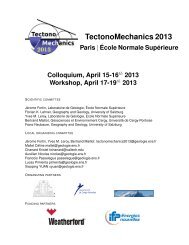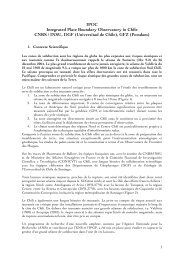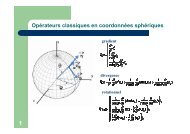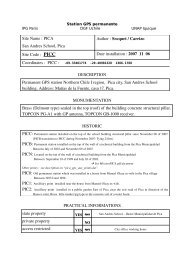PDF file - Laboratoire de Géologie de l'Ecole normale supérieure - Ens
PDF file - Laboratoire de Géologie de l'Ecole normale supérieure - Ens
PDF file - Laboratoire de Géologie de l'Ecole normale supérieure - Ens
Create successful ePaper yourself
Turn your PDF publications into a flip-book with our unique Google optimized e-Paper software.
Figure 4. African plate stations residual velocities with<br />
respect to our <strong>de</strong>termination of the African plate<br />
motion. Velocity magnitu<strong>de</strong>s (top) and velocity<br />
components (bottom) in mm/yr. Light grey sha<strong>de</strong>d<br />
symbols <strong>de</strong>pict stations with high velocity uncertainties<br />
or lying in <strong>de</strong>formation zones (usually not used in the<br />
pole <strong>de</strong>termination).<br />
VIGNY ET AL.: ARABIA PLATE MOTION<br />
9<br />
discrepancies of 2 to 4 mm/yr at these northern sites. At<br />
other sites (MALI, REUN, SEY1), the difference is<br />
small. Although the angular velocity vector is not as<br />
well constrained as the Africa one, we are thus fairly<br />
confi<strong>de</strong>nt that our <strong>de</strong>termination of the Somalia motion<br />
provi<strong>de</strong>s a better estimate than previously done, a point<br />
that will be critical when <strong>de</strong>aling with relative motion<br />
around the Africa-Arabia-Somalia triple junction.<br />
Because it uses data in the northern part of the Somalia<br />
plate, our Somalian angular velocity vector provi<strong>de</strong>s a<br />
better estimate of the motion of Arabia with respect to<br />
the nearby part of Somalia, which was not the case with<br />
previous mo<strong>de</strong>ls.<br />
Arabia<br />
In this work, the Arabia plate motion is constrained by a<br />
total of eleven sites: four stations in Yemen (DHAM,<br />
HODD, JNAR and SANA), two in Oman (MUSC,<br />
KHAS), one in Bahrein (BAHR) and two in Iran<br />
(KHOS, REIH), one in northern Djibouti, on the stable<br />
Danakil block (RSB0) and one in Jordan (AMMN)<br />
(Figure 3). We did not use DRAG in our kinematic<br />
inversion because it shows elastic coupling with the<br />
Levant Fault. In terms of the number of sites and, even<br />
more important, spatial coverage, this is a significant<br />
improvement over previous mo<strong>de</strong>ls that used from only<br />
two [Sella et al., 2002], four [McClusky et al., 2003]<br />
and six [Vernant et al., 2004]. Velocities of those 11<br />
stations fit a rigid rotation about an angular velocity<br />
vector (52.26°N, 12.27°W, 0.470°/Myr). The RMS<br />
residual is 1.2 mm/yr, although one station (AMMN)<br />
shows a very large misfit (9 mm/yr). Although no<br />
technical problem has been reported, the time series<br />
available show that the north component of the velocity<br />
does not fit a straight line. Discarting this station gives<br />
an angular velocity vector (52.59°N, 15.74°W,<br />
0.461°/Myr) (Table 3), thus more to the West at nearly<br />
the same latitu<strong>de</strong> and accordingly with a smaller rate.<br />
As for Africa and Somalia, we checked that our solution<br />
is stable with respect to the inversion scheme.<br />
<br />
Table 3. Rotation parameters of Africa (AFR), Somalia (SOM), Arabia (ARA), and India (IND) with respect to<br />
ITRF2000 (ITRF-97 for Sella et al.). Uncertainty on the pole location is given by the semi-major ( maj) and semiminor<br />
( min) axes of the - error ellipse (azim. is the azimuth of the semi-major axis)<br />
Plate Lat.°N Long.°E Rate Rate σ σmaj σmin azim. Reference<br />
°/Myr °/Myr (°) (°) (°)<br />
AFR 50.48 -82.01 0.265 0.003 1.26 0.74 276 this work<br />
46.64 -86.32 0.251 Calais et al. [2003]<br />
50.86 -81.47 0.261 0.002 1.03 0.60 95 Fernan<strong>de</strong>s et al. [2003]<br />
52.25 -80.18 0.253 0.004 1.6 0.9 277 Sella et al. [2002]<br />
SOM 48.12 -97.75 0.329 0.008 4.36 0.70 316 this work<br />
54.63 -93.61 0.315 0.007 2.30 0.73 54 Fernan<strong>de</strong>s et al. [2003]<br />
53.51 -101.55 0.310 0.002 0.9 0.1 42 Sella et al. [2002]<br />
ARA 52.59 -15.74 0.461 0.011 2.98 0.42 81 this work<br />
51.47 2.89 0.521 0.024 3.1 0.7 290 Sella et al. [2002]<br />
IND 50.90 -12.13 0.487 0.010 5.11 0.61 288 Socquet et al. [2004]






